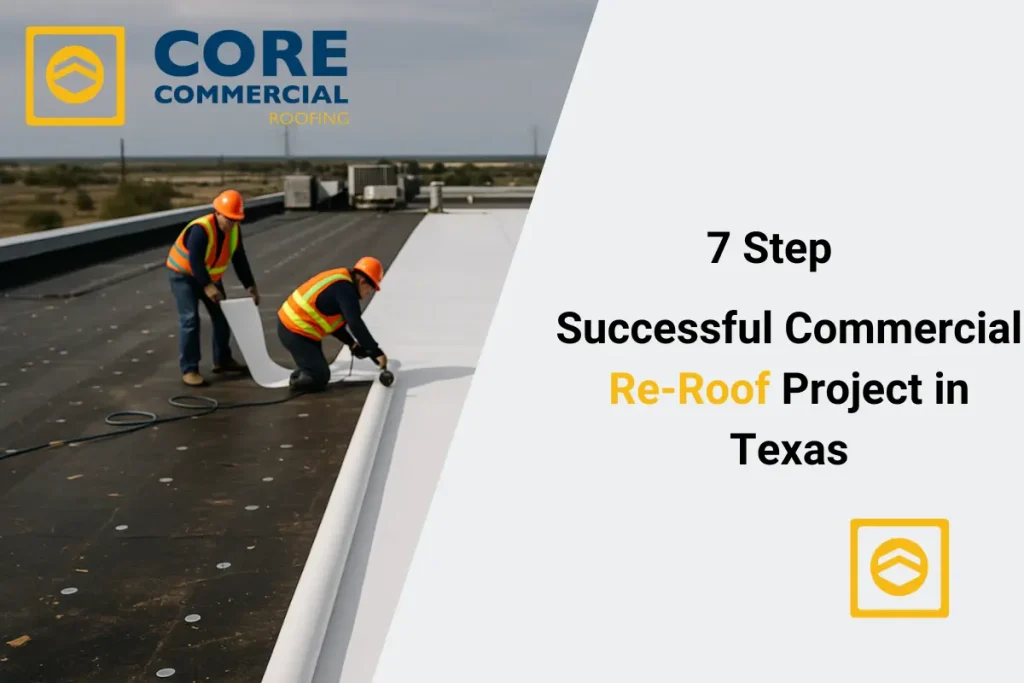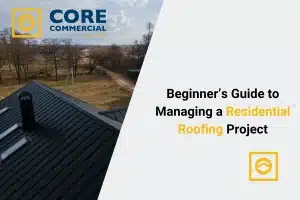A commercial roof replacement is one of the biggest investments a property owner or facility manager will face, and getting it right is critical. A roof that is planned and installed well will protect your building, lower future repair costs, and extend the overall life of your property.
Among all the steps involved, our favorite method is starting with a thorough roof inspection. A detailed inspection not only identifies hidden damage but also provides the foundation for making smart decisions about materials, scheduling, and budget. When each stage is handled with care, you can avoid costly mistakes and complete a successful commercial re-roof project that delivers long-lasting value. In this article, we’ll walk through the seven steps every Texas business should follow to ensure the Commercial Re Roof Project in Texas runs smoothly from start to finish.

Table of Contents
Step 1: Start with a Comprehensive Roof Inspection
Every successful commercial re-roof project begins with an accurate understanding of the current condition of the roof. Skipping this step often leads to surprises later, such as hidden leaks, weak decking, or poor drainage systems.
A professional inspection includes walking the roof surface, checking seams and flashing, and evaluating insulation. Core samples may also be taken to see the condition of layers beneath the surface. The benefit of a proper inspection is that you know exactly what needs to be repaired or replaced before moving forward. This helps prevent unexpected expenses and ensures the right re-roofing plan is created for your specific building.
In Texas, where weather patterns range from scorching summers to heavy storms, inspections also highlight areas vulnerable to high winds, UV damage, and water ponding. Addressing these early reduces the risk of structural issues later.
Step 2: Define Clear Goals and a Budget for the Project
Once the inspection is complete, the next step is setting clear goals for your project. Ask yourself:
- Do you want to extend the roof’s life with minimal repairs, or is a full replacement needed?
- Are you focused on lowering energy bills with better insulation?
- Is the priority durability against Texas storms?
By outlining these goals, you can choose the best roofing system and materials to match your needs. At the same time, establish a realistic budget. Commercial roofing projects often involve multiple costs, such as labor, materials, equipment, permits, and waste removal. Building in a small buffer for unexpected issues ensures you won’t be caught off guard financially.
Defining goals and budget early creates a roadmap that keeps the entire project on track.
Step 3: Select the Right Roofing Materials
Choosing materials is one of the most important decisions in a commercial re-roof project. The type of roofing system you select will determine not only the cost but also the performance and longevity of the roof.
Popular options in Texas include:
- TPO Roofing: Energy-efficient and reflective, great for hot climates.
- Modified Bitumen: Durable and reliable, especially for flat roofs.
- Metal Roofing: Long lifespan and excellent resistance to wind and hail.
- EPDM Rubber: Affordable and flexible, though less reflective.
Each option comes with its own benefits, so it’s important to weigh them against your project goals. For example, if lowering cooling costs is a priority, TPO may be the best choice. If longevity is key, metal roofing could be worth the higher upfront cost.
A knowledgeable contractor can explain how each material performs in Texas conditions and help you select the best match for your building.
Step 4: Hire an Experienced Commercial Roofing Contractor
No matter how good the materials are, the success of your re-roof project ultimately depends on the skill of the contractor. Hiring an experienced, licensed, and insured roofing company ensures the project is completed safely and correctly.
When choosing a contractor, look for:
- A proven track record with commercial projects.
- Strong local references and reviews.
- Clear communication about timelines and costs.
- Safety certifications and insurance coverage.
An experienced contractor understands Texas building codes, weather challenges, and the logistical needs of working on occupied commercial properties. They will also help coordinate permits and inspections, saving you time and reducing stress.
Step 5: Plan the Project Timeline and Logistics
Re-roofing a commercial property can be disruptive if not planned well. That’s why creating a detailed timeline is crucial. The project should be scheduled at a time that minimizes impact on daily business operations.
Texas weather is another factor. Scheduling the project during milder seasons helps avoid delays from extreme heat or storms. A good contractor will build a contingency plan for unexpected weather changes to keep the project on schedule.
Logistics are also key. Arrangements must be made for equipment access, waste removal, and worker safety. For large properties, sections of the roof may be completed in phases to ensure parts of the building remain usable. Clear communication with tenants, employees, or customers reduces frustration and helps the project flow smoothly.
Step 6: Ensure Quality Installation and Regular Oversight
The installation phase is where all the preparation comes together. Proper installation techniques are essential for long-term roof performance. Even the best materials will fail if seams are not sealed correctly or flashing is poorly installed.
Regular oversight during installation helps catch problems early. Many building owners choose to have progress reports or inspections at different stages of the project. This ensures the contractor is following the plan, safety protocols are observed, and the work is up to standard.
In addition, using high-quality fasteners, adhesives, and sealants adds to the durability of the roof. With Texas weather extremes, this attention to detail can make the difference between a roof that lasts decades and one that requires repairs within a few years.
Step 7: Perform Final Inspection and Create a Maintenance Plan
Once the installation is complete, a final inspection confirms the roof meets all project goals and code requirements. This inspection should include checking seams, flashing, drainage systems, and any penetrations. Documentation such as warranties and photographs should also be provided.
But the process doesn’t end there. A successful commercial re-roof project includes planning for long-term maintenance. Regular roof inspections, at least twice a year, help identify small problems before they become major repairs. Cleaning debris, maintaining gutters, and checking drainage systems extend the roof’s lifespan.
By creating a maintenance plan right after completion, you protect your investment and avoid unexpected future costs.
Benefits of Following These Seven Steps
Taking the time to follow each step has long-lasting benefits for building owners and managers:
- Financial savings: A well-planned re-roof reduces unexpected costs.
- Better performance: Choosing the right materials ensures durability in Texas weather.
- Fewer disruptions: Careful scheduling keeps business operations running smoothly.
- Peace of mind: Regular oversight and maintenance protect your investment.
These steps don’t just lead to a finished roof; they result in a successful commercial re-roof project that provides safety, comfort, and reliability for years to come.
Conclusion
A commercial roof replacement may feel overwhelming at first, but with the right preparation and decisions, the process can be smooth and rewarding. Beginning with a thorough inspection, defining your goals, and choosing the right materials are key to building a strong foundation. Partnering with experienced contractors, planning logistics carefully, ensuring quality installation, and committing to maintenance all work together to guarantee success.
By following these seven steps, Texas property owners can avoid common mistakes and enjoy the benefits of a roof that stands strong against heat, storms, and the test of time. A successful commercial re-roof project is not just about replacing a roof. It’s about creating long-term value for your building and peace of mind for everyone who relies on it.
FAQs
What are the signs my commercial roof needs replacing in Texas?
Common signs include water stains on ceilings, frequent leaks, bubbling or blistering on the roof surface, sagging areas, and if the roof is over 20 years old. Texas weather, like intense sun and storms, can speed up roof aging. Regular inspections help catch these issues early.
How much does commercial roof replacement cost in Texas?
The cost varies based on materials and roof size. On average, expect to pay between $4 to $13 per square foot. For example, TPO roofing may cost around $5.20 per square foot, while metal roofing can range from $7 to $13 per square foot. Getting multiple quotes can help you find the best deal.
Do I need a permit to replace a commercial roof in Texas?
Yes, most cities in Texas require permits for commercial roof replacements. The requirements can vary by location, so it’s essential to check with your local building department or have your contractor handle the permitting process to ensure compliance with local codes.
What is the best roofing material for commercial buildings in Texas?
TPO and PVC are popular for their energy efficiency and durability in hot climates. Metal roofs are also favored for their longevity and resistance to extreme weather. The best choice depends on your building’s needs and budget.
How often should I inspect my commercial roof in Texas?
It’s recommended to inspect your commercial roof at least twice a year, preferably in the spring and fall. Additionally, inspections should be conducted after major storms to identify and address any damage promptly.
Can I layer a new roof over an old one in Texas?
While it’s possible to install a new roof over an existing one, it’s not always advisable. Texas building codes and the condition of the existing roof will determine if this is feasible. A professional inspection can guide the best approach.
How long does a commercial roof last in Texas?
The lifespan varies by material. TPO and PVC roofs can last 20-30 years, while metal roofs may last 40-60 years. Regular maintenance can extend the life of your roof, regardless of the material.
What maintenance does a commercial roof need post-replacement?
Regular maintenance includes biannual inspections, cleaning gutters and drains, checking for and repairing minor damages, and ensuring that rooftop equipment is secure. Proper maintenance helps extend the roof’s lifespan and prevents costly repairs.
Are there energy-efficient roofing options for Texas climates?
Yes, materials like TPO and PVC are reflective and help reduce cooling costs by reflecting sunlight. Metal roofs with reflective coatings are also energy-efficient choices suitable for Texas’s hot climate.
How do I choose a reliable commercial roofing contractor in Texas?
Look for contractors with proper licensing and insurance, positive customer reviews, experience with commercial projects, and familiarity with local building codes. It’s also beneficial to choose contractors who offer warranties and have a solid track record in the Texas area.






